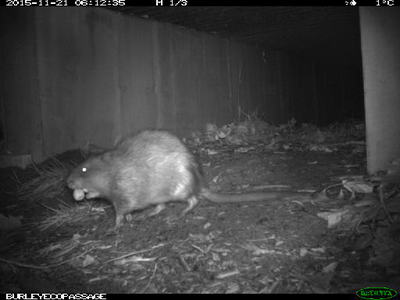
One of the best parts about spring is that it offers some of the best viewing opportunities for two of Algonquin Provincial Park’s most famous mammals.
May has become famous for moose watching in Algonquin, but April is prime time for viewing its smaller, toothier associate: the beaver.
~
What makes April prime time for beaver watching?
During the month of April, as the warmth of the spring sun melts the winter ice, Algonquin’s ponds slowly begin to open up.
These ponds are home to the park’s beaver population, and after a long winter spent mostly restricted to their lodge and under the ice, they are quick to embrace the freedom of spring!

When summer visitors spot beavers in the park, they will likely see a beaver swimming across a pond from a distance, their bodies mostly submerged.
April visitors are able to see the beavers out of the water, perched on the ice in the fresh spring air.
The ledges of ice on the partially melted ponds quickly become an open-air spa and patio for grooming and feeding. They also provide them with a quick escape into the water should a predator approach.

As they groom and feed, park visitors can also witness beaver behaviour not as easily seen in the other months. These few weeks in April easily provide the best viewing opportunities of the whole year.
Note: prime beaver watching season is brief in the park. Ideal conditions exist when ponds are partially melted. Exact timing can vary year to year but often early-mid April is best. The best place to look for them is where the ice ledges meet the open water.
~
Best locations for spring beaver-watching in Algonquin
Opeongo Road
One of the best spots in the park for spring beaver watching is down Opeongo Road just off Highway 60 on the north side at km 46.3.
This road features multiple beaver ponds with lots of beaver activity. This road has significantly less traffic than the highway, making it best for wildlife viewing.
There are designated parking spots along the roadside. Please do not park on the narrow shoulders.
Highway 60
Driving along Highway 60, you will undoubtedly see lots of beaver activity in the roadside wetlands.
If you wish to stop, please do so along the designated parking spots and remember it is a busy provincial highway.

~
Wildlife viewing guidelines
- Maintain a respectful distance from wildlife – a respectful distance permits the animal to continue behaving normally and provides it with a clear path to move away from people. A respectful distance would be minimum 10-15 metres (33-50 feet)
- Do not overstay your welcome – it’s an amazing experience to spend time observing wild animals, however, watching them for prolonged periods of time could stress them out. Know some of the signs of stressed wildlife, and move on before this time (in this case, beavers will slap their tail on the water’s surface)
~
Some other wet and furry animals you might see on the edge of the ice
Beavers aren’t the only animals taking advantage of the newly melted ice.
Muskrats, a regular inhabitant of the beaver pond, may also be seen on the edge of the ice, doing much the same thing as beavers – grooming and feeding.

You might think a Muskrat is a baby beaver as they do look quite similar. Look for its long, narrow tail instead of the paddle-shaped tail of the beaver.
A couple of semi-aquatic weasels also get comfortable on the edge of the ice. The American Mink has a reddish-brown pelt and moves quickly along the waters’ edge, and is an accomplished swimmer.
The other weasel, the River Otter, is much larger than the mink. It may be seen in small, family groups. Otters are quite playful, and their antics delight photographers.
~


